If you’ve ever found yourself amid a construction project, armed with a plethora of tools but unsure of which one to wield, then this article is for you. This guide is here to settle the age-old debate once and for all: sledgehammer or mallet? Both may seem like ordinary tools at first glance, but they each possess unique qualities that make them suited for specific tasks. So, stop swinging blindly and start knowing which tool is truly the best for your needs. Dive into the world of hammers and mallets and uncover the key differences between them.
What is a Sledge Hammer?
A sledgehammer, also known as a slugger, is an indispensable heavy-duty tool widely used in various construction and demolition works. It is designed with a long-handled configuration to provide ample leverage and force for efficient execution.
The head of a sledgehammer is typically made of durable materials such as steel or iron, ensuring its ability to withstand intense impact. This robust metal head is securely attached to the end of a carefully crafted handle, which can be made from either solid wood or reinforced fiberglass. The choice of handle material depends on personal preference and the specific requirements of the task at hand.
The primary purpose of a sledge hammer is to facilitate demolition tasks with utmost efficiency. It excels at breaking down concrete and brick walls, reducing rocks into smaller, more manageable pieces, driving in sturdy stakes, and undertaking similar demanding assignments. However, it is important to approach the use of a sledge hammer with caution and practice proper techniques to prevent potential injuries caused by mishandling.
By its robustness, versatility, and effectiveness, the sledge hammer has become an indispensable tool in the arsenal of construction professionals and enthusiasts alike. Its ability to deliver powerful blows with precision and control makes it an essential companion for any project that requires forceful impact and controlled destruction [1].
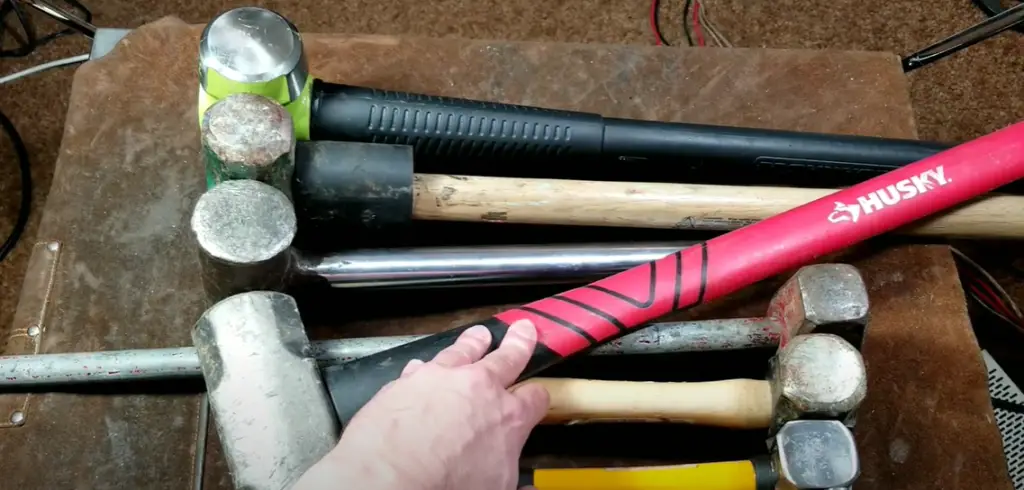
What is a Mallet?
A mallet, a specialized type of hammer, is characterized by its heavy head and is primarily employed for pounding or driving objects like nails into surfaces. Its design makes it particularly well-suited for carpentry and various construction tasks.
The handle of a mallet is commonly crafted from materials such as wood, plastic, or metal, providing enhanced control when striking objects. In addition to its applications in carpentry, mallets find widespread use in blacksmithing, stone carving, and other activities that demand the precise application of force.
The versatility and reliability of the mallet make it an indispensable tool in various trades and crafts. You can surely use it to drive nails and screws into wood or other materials, but it is also great for chiseling, forming metal components, striking trowels, smoothing surfaces, and more. For example, when working with stone, a mallet is often used to set the position of sharp chisels and other tools.
Often confused with hammers, mallets are not as powerful but serve their own purpose in certain craftsman tasks. If you need more force than the mallet can provide, it’s best to go for a hammer instead. A well-made mallet has a head made of sturdy material, such as lead, plastic, rubber, or wood. The handle is usually crafted from hardwood and provides the user with comfort and control when pounding objects [2].
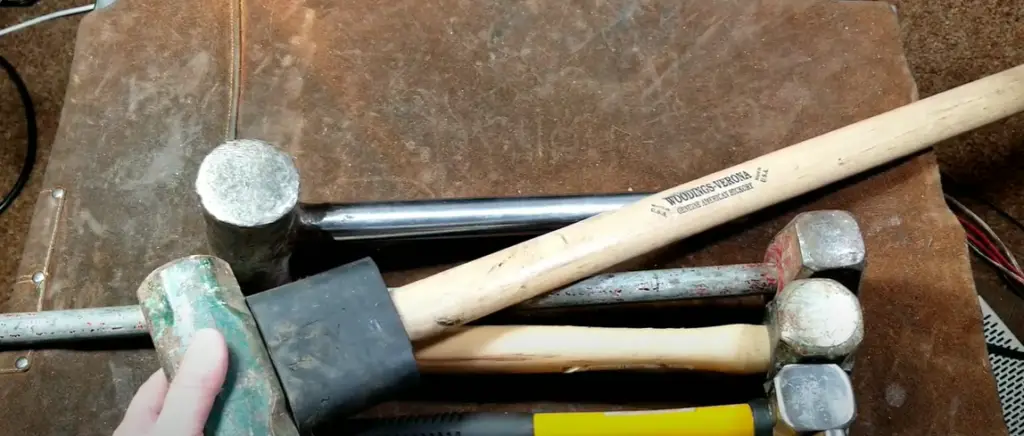
What Type Of Sledgehammer Is Right For You?
When it comes to choosing the right sledgehammer for your job, there are a few key considerations you should keep in mind. First of all, you’ll want to choose a hammer that is sturdy and fits comfortably in your hand. You’ll also want to take into account the type of material you’re using, as this will determine the size and weight of the hammer you’ll need.
If your job requires more precision, then you might want to consider using an engineer’s hammer. This type of hammer has a smaller head and is designed for finer work. It’s great for driving nails or screws into small spaces, and it can also be used to remove tough materials like tree stumps or bricks with its chisel-like end.
For those who need brute force, then you’ll want to go with a splitting maul. This hammer is designed for breaking apart logs and other dense materials. It has a wedge-shaped head that makes it easier to use when working with tough materials.
No matter what type of sledgehammer you need, make sure it’s comfortable to hold and easy to use. The right tool can make any job easier – so be sure to find the one that’s right for you!
An important factor to consider when selecting a sledgehammer is safety. Make sure the handle is securely attached and there’s no risk of it snapping off while in use. If possible, wear safety glasses or goggles when hammering in case any debris flies up at your face. It’s always better to be safe than sorry!
What Type Of Mallet Is Right For Your Job?
Wooden Mallets
Wooden mallets are a great choice for everyday woodworking projects. They come in a variety of shapes and sizes, from small hand tools to large industrial hammers. Wooden mallets are usually made of hardwood such as oak or maple, making them resistant to splitting or breaking. They provide enough force to drive nails into the wood without damaging the material. Wooden mallets also work well for softer materials such as plastics and metals, but they may not be strong enough to drive nails into harder materials like concrete.
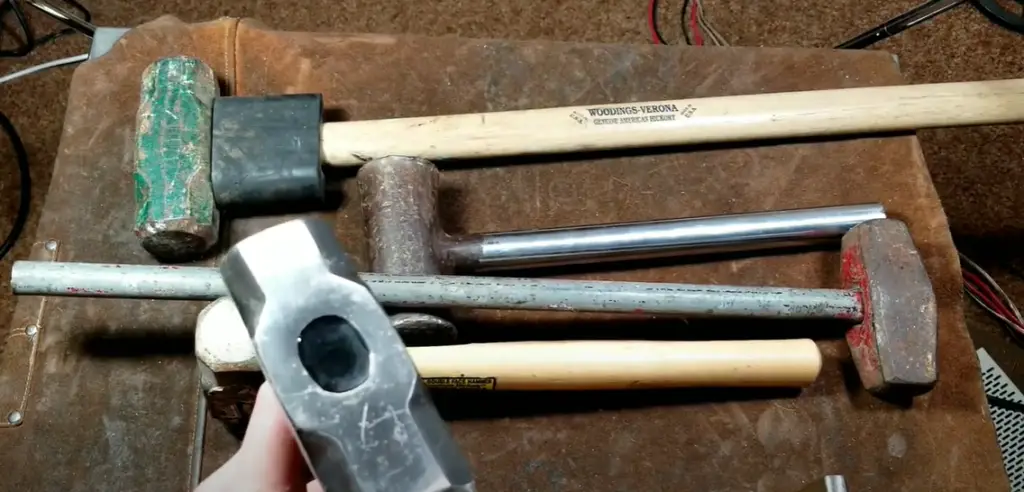
Metal Mallets
Metal mallets are the ideal choice for heavy-duty projects. With their exceptional strength and durability, these mallets come in a range of sizes and shapes, catering to both home and professional needs. Designed to offer precise control, metal mallets are less prone to chipping or splintering compared to their wooden counterparts. This makes them perfect for driving large nails into tough materials such as concrete. When you require a reliable and efficient tool, a metal hammer is undoubtedly the best option for the job at hand.
Rubber Mallets
Rubber mallets are the perfect choice when you want to ensure the surface of your work material remains unharmed. With just the right amount of force, they effortlessly drive nails into wood, while their softer and more flexible heads make them an excellent tool for intricate projects such as installing delicate ceramic tiles or precisely setting stones. Moreover, rubber mallets are highly compatible with plastic items, as they provide exceptional protection against scratches or any damage to the material. With their versatility and gentle touch, rubber mallets are a must-have for any project requiring finesse and precision [3].
Mallet Vs Sledge Hammer? When to use one or the other?
When it comes to hammering, not all hammers are the same. For certain tasks, one hammer type may be more effective than another. Mallet and Sledgehammers are two common types of hammers used for a variety of projects. Knowing when to use either a mallet or sledgehammer is very important for our safety as well as the success of our project.
Mallets are hammers with a large, flat head and handle usually made from wood or rubber. They have a wide surface area so that they can apply more force to the material while distributing it evenly over the working surface. Mallets are most commonly used for carpentry projects like tapping chisels, adjusting cabinet doors, or knocking apart furniture.
Sledgehammers are much larger than a mallet, and have a heavy metal head with a short handle. Sledgehammers are used for heavier jobs like breaking up concrete or rocks, driving stakes into the ground, or removing old wooden posts. They are also great for the demolition of walls and other structures because they can deliver more force in one blow than a mallet.
No matter what type of hammer you choose, it is important to use the proper safety equipment and techniques when hammering. Be aware of your surroundings, wear protective gear such as goggles and gloves, and never strike metal with a sledgehammer or other heavy object. Hammering can be dangerous if not done correctly, so make sure to be aware of the potential risks. With the right knowledge and tools, you can easily choose between a mallet or a sledgehammer for your next job [4].
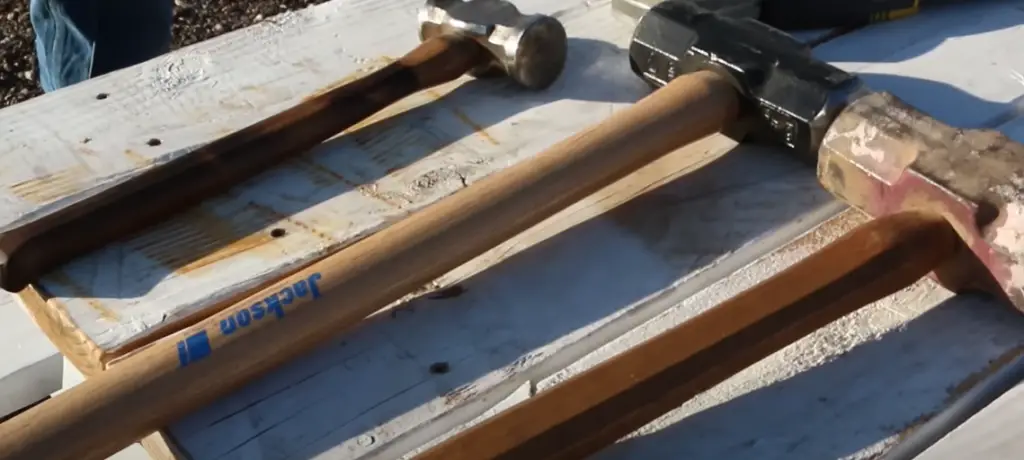
Tips for cleaning and maintenance of mallets and sledgehammers
Making sure your hammer is in top condition will make it last longer. Here are some tips for cleaning and maintenance:
- Always use a soft cloth to clean the head of any hammer, wiping away dirt, dust, and debris that accumulates over time.
- After each use, apply a light coating of lubricant such as WD-40 to the head of the hammer. This will help protect it from rust and corrosion.
- If necessary, sand down any nicks or burrs that may have formed on the head of the hammer over time.
- For mallets and sledgehammers, check the handle regularly for signs of wear and tear, and replace it as needed.
- When storing your hammer, keep it in a dry, cool location. This will help extend its lifespan.
- Be sure to inspect the head and handle of your hammer before each use to make sure that it is in good condition and safe to use.
- If you plan on using your hammer in cold climates, be sure to protect it from extreme cold temperatures with a coat of petroleum jelly or other lubricant.
By following these simple tips, you can ensure that your hammers are in top condition and ready for use whenever needed. With proper care and maintenance, you can extend the life of your hammer and get the most out of it for years to come.
FAQ
Is a sledgehammer a mallet?
No, a sledgehammer is not the same as a mallet. A sledgehammer is much larger and heavier than a mallet and it has an elongated metal handle. The head of the sledgehammer can be either flat or have a pointed end depending on its intended use. Mallets have shorter handles and smaller heads made usually from wood or rubber. Their use is for lighter, more precise striking and to avoid damaging the surface they are hitting.
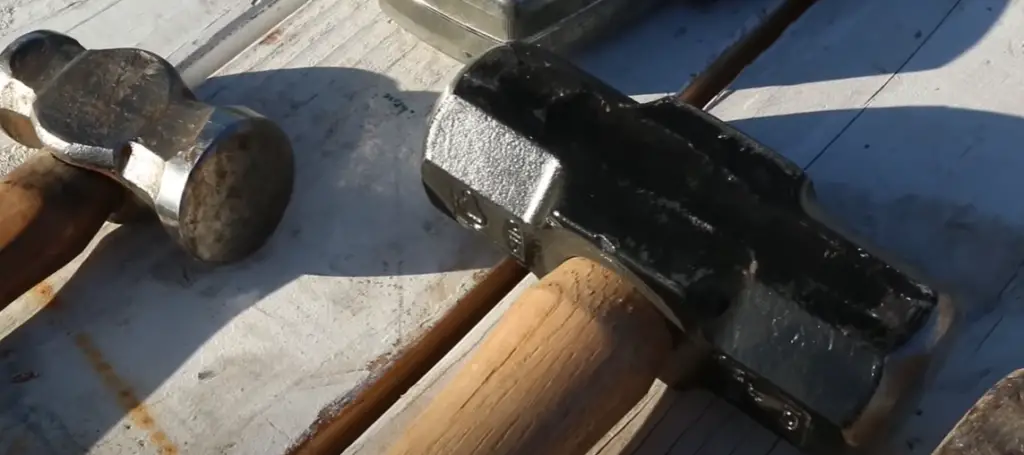
What is a ball peen hammer?
A ball peen hammer, also known as a machinist’s hammer, is a versatile tool with two distinct ends. One end features a flat surface, similar to that of a regular claw hammer, while the other end is rounded like a ball. This unique design allows the ball peen hammer to excel in metalworking tasks, as it can effectively shape and form metal surfaces.
In metalworking, the flat end of the ball peen hammer is commonly used for striking and shaping metal, while the rounded end serves various purposes. It can be employed to create smooth radiuses, eliminating dents or scratches on metal surfaces. Additionally, the rounded end is particularly useful for riveting, allowing for secure and precise fastening of metal components.
With its ability to manipulate and refine metal, the ball peen hammer is an indispensable tool in the arsenal of metalworkers, blacksmiths, and artisans alike. Its versatility and effectiveness make it a must-have for anyone working with metal surfaces.
What is a dead blow hammer?
A dead blow hammer is a type of sledgehammer that has a hollow head filled with steel shot, sand, or lead shot. The filling helps absorb the shock of impact, allowing for a much more controlled hammering action with less rebound than a conventional sledgehammer. As such, dead blow hammers are ideal for applications requiring precise and powerful strikes, such as automotive bodywork or blacksmithing.
The handle of a dead blow hammer is usually made from either wood or fiberglass, and its length is typically between 12 and 24 inches. Due to the added weight of the steel shot or other filling material, dead blow hammers are much heavier than traditional sledgehammers. This makes them less suitable for extended swinging but more efficient for powerful, controlled strikes in a specific area.
What is a framing hammer?
A framing hammer is a type of claw hammer specifically designed for structural construction tasks. It has a longer and heavier handle than the average claw hammer, along with a flatter striking face that allows it to drive nails straight. The claw on the back of the head is also curved inwards at a greater angle, making it easier to pull nails out from wood surfaces without damaging them.
The weight of a framing hammer is typically between 20 and 32 ounces, making it heavier than both the average claw hammer and dead blow sledgehammer. This added weight ensures that each strike is powerful enough to drive nails in place without any additional effort from the user. Additionally, most framing hammers come with a shock-absorbing rubber or vinyl grip, allowing for greater control and comfort during extended hammering sessions.
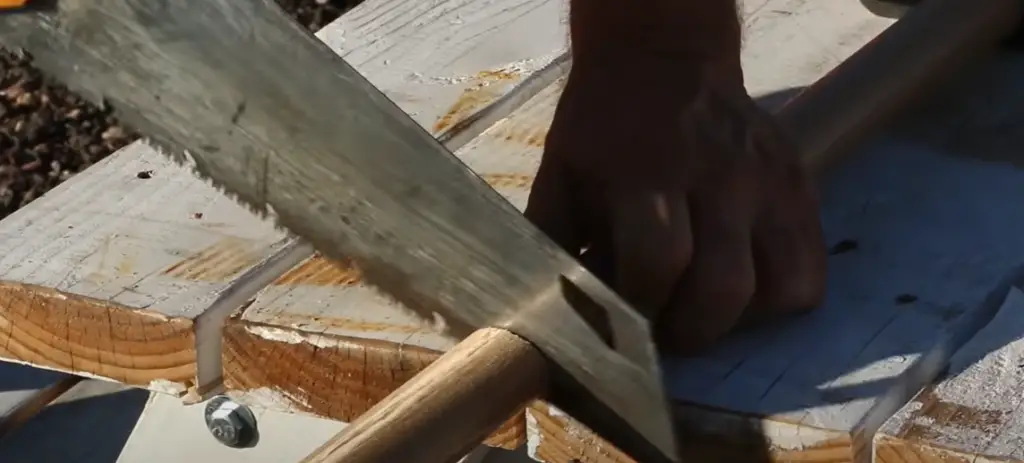
What is the difference between a sledgehammer and a maul?
The main difference between a sledgehammer and a maul is in the size and shape of their heads. A sledgehammer features an elongated head with either a flat or pointed end, while a maul has a much bigger, cylindrical head with blunt edges.
Mauls are also much heavier than sledgehammers, as they are designed to be used for splitting logs and other tougher objects. The head of a maul also features a cross-shaped design with openings on the side, allowing it to easily break through tough materials without damaging them. Conversely, a sledgehammer is best suited for pounding or driving in nails and stakes into the ground.
Overall, mauls are better for large-scale construction tasks while sledgehammers are more suited for smaller projects. With the right type of tool on hand, any job can be completed efficiently and safely.
What is a drywall hammer?
A drywall hammer is a specialized tool designed specifically for hanging drywall sheets. It features a pointed head which can be used to easily punch through drywall and into the wall studs beneath it. This is especially useful for hanging heavier drywall sheets without having to use nails or screws. The handle of a drywall hammer is typically made from wood, although some versions also have rubberized grips for added comfort during extended use.
In addition to hanging drywall sheets, a drywall hammer can also be used for cutting and shaping smaller pieces of the material. The pointed head allows you to easily score the surface of the drywall to create clean lines and edges when cutting it down into more manageable sizes.
What is the difference between a hammer and a mallet hammer?
The main difference between a hammer and a mallet hammer is in the shape of their heads. A regular hammer has a flat head, while a mallet hammer has either a cylindrical or octagonal head with rounded edges. The design of the mallet hammer allows it to be used for softer applications such as striking wooden surfaces without causing damage.
The handle of a mallet hammer is also typically shorter than that of a regular hammer, making it better suited for precision tasks. Additionally, the head is usually made from either wood or rubber rather than metal, allowing for a softer strike while still providing enough power to get the job done.
Why use a mallet instead of a hammer?
Mallets are ideal for applications that require accurate and gentle strikes. The cylindrical or octagonal shape of the head cushions the blow, making it suitable for use on more delicate materials such as wood or metal without causing damage. Additionally, the handle is usually shorter than a regular hammer, allowing for greater control when working on finer details.
With its versatility and gentle striking action, a mallet is an essential tool for any metalworker or woodworker. Combining accuracy and power in one tool can make the difference between a job done right or one that needs to be redone.
No matter the task at hand – whether it’s pounding in stakes, riveting together metal parts, or working on delicate woodworking projects – having the right tool on hand can make all the difference. From sledgehammer to framing hammer, dead blow hammer to mallet, each tool in your arsenal has a specific purpose and with the right knowledge, you’ll be ready for any job that comes your way.
Who uses mallets?
Mallets are commonly used by woodworkers, metalworkers, blacksmiths and sculptors. Woodworkers use mallets for tasks such as fine carving or shaping wooden pieces without damaging them. Metalworkers and blacksmiths use mallets to strike metal objects together while sculptors use them for tasks such as smoothing out rough surfaces on stone sculptures. Mallets are also frequently used by jewelers and watchmakers for tasks such as setting gemstones securely in place.
Overall, mallets are great tools to have on hand for any task that requires precise strikes with minimal damage or noise. With the right selection of hammers and mallets, you’ll be ready for anything that comes your way.
What is the difference between a soft hammer and a mallet?
The main difference between a soft hammer and a mallet is in the material used for their heads. Soft hammers typically have rubber or plastic heads which are designed to absorb shock when striking harder materials, while mallets usually have wooden, metal or stone heads with rounded edges.
Soft hammers also feature longer handles than mallets to reduce fatigue during extended hammering sessions, making them better suited for tasks such as pounding metal stakes into the ground. On the other hand, mallets are often used for more precise tasks such as shaping wood or smoothing out stone surfaces.
Useful Video: SledgeHammer Overview & Comparison
Conclusion Paragraph
Sledgehammer and Mallet are two of the most popular hammers on the market today. Both are great tools for a variety of applications, from pounding nails into wood to chipping away at stubborn rocks. The key difference between the two is that sledgehammers are heavier and have larger heads than mallets, allowing them to deliver more force with each blow. When it comes to selecting which hammer is right for you, it’s important to consider the tasks you’ll be using it for and how much force is required. If you’re looking for a hammer that can handle tough jobs with ease, then a sledgehammer is your best bet. But if precision and lighter weight are what you need, then a mallet might be more suitable.
References:
- https://www.aboutmechanics.com/what-is-a-sledgehammer.htm
- https://www.aboutmechanics.com/what-is-a-mallet.htm
- https://www.thespruce.com/rubber-mallet-uses-1822687
- https://www.homestratosphere.com/mallet-vs-sledge-hammer/






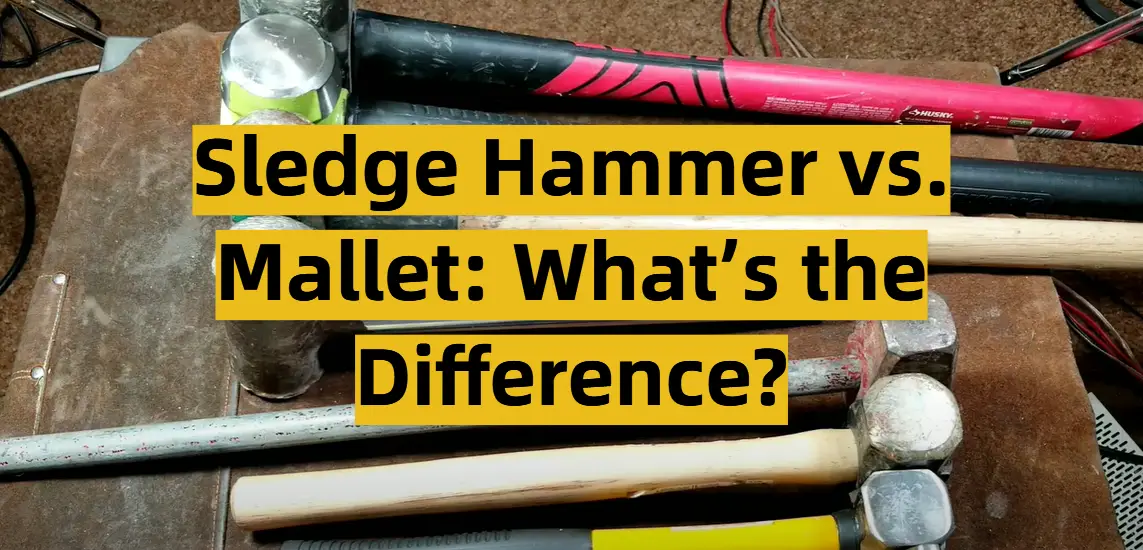






Leave a Reply